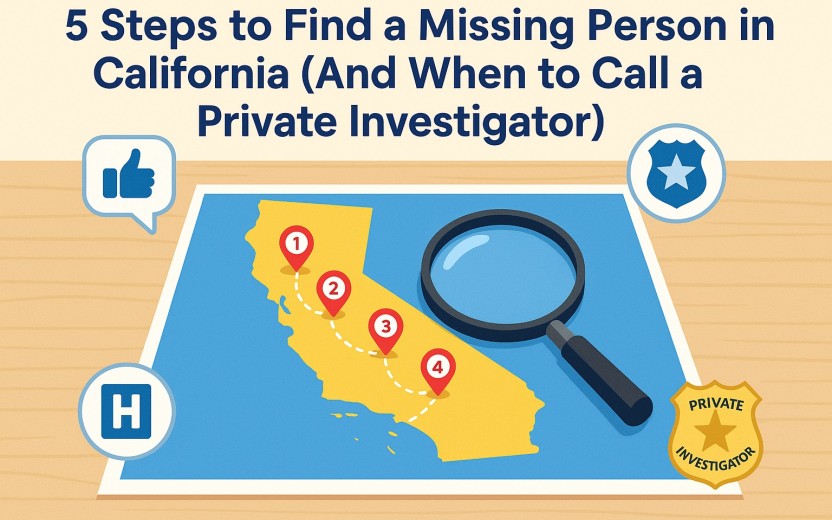Steps You Can Take to Find a Missing Person (And When to Call a PI)
5 Steps You Can Take to Find a Missing Person (And When to Call a PI)
When a loved one goes missing, it’s easy to feel overwhelmed and powerless. The good news is that you don’t always need to hire a professional investigator right away. In fact, there are effective DIY steps you can take immediately to begin the search.
Most missing person cases are resolved quickly — according to NamUs (National Missing and Unidentified Persons System), 99% of missing individuals were located in 2012, with only 2,079 of 661,000 cases still unresolved. By taking prompt action on your own, you can greatly improve the chances of a quick reunion.
This guide will walk you through five key steps: from gathering essential information and leveraging free resources (social media, shelters, hospitals, public records), to understanding when to involve the police, and finally recognizing when it’s time to call a private investigator.
Step 1: Gather Essential Information First
Before anything else, collect all vital information about the missing person. Having detailed, accurate info will aid both your own search and any officials or investigators later.
- Start with basics: full name, age, physical description, and unique identifiers (height, weight, hair/eye color, tattoos, scars, glasses, medical conditions, etc.).
- Secure a recent clear photo that shows them as they currently appear.
- Compile a list of close contacts — friends, relatives, coworkers, neighbors — who may have seen or heard from them recently.
- If possible, get a cell phone bill or call log to see who they last communicated with.
Document the last known whereabouts and timeline: when and where they were last seen, what they were wearing, and what they were doing or planning. For example, note if they mentioned plans to meet someone.
Finally, keep a notebook or digital log of all details, sightings, and calls. This running record will help you track progress and will be invaluable if law enforcement becomes involved.
Step 2: Leverage Social Media and Online Networks
Social media can be a powerful (and free) tool to help find missing persons.
- Check their accounts (Facebook, Instagram, X/Twitter, etc.) for recent activity. On platforms like Instagram, you can see the last active timestamp in your direct messages.
- Post a public alert with their photo and key details (description, last known location, date/time missing, distinguishing traits) and ask people to share it. A viral post can reach thousands of people within hours.
- Join local Facebook groups, neighborhood apps, or missing-person forums (such as r/MissingPersons on Reddit).
- Directly message friends/followers to see if anyone has information.
- Try people-finder sites like TruePeopleSearch or FamilyTreeNow for recent addresses.
Even a quick Google search of their name or username might turn up useful leads.
Step 3: Check Local Shelters, Hospitals, and Public Records
While you work online, also check institutions that may have encountered the missing person:
- Hospitals and urgent care centers — call and provide a detailed description; some patients may be unidentified.
- Homeless shelters — especially if the person is vulnerable.
- Local jails/police holding facilities — use California Inmate Locator or call the local Sheriff station.
- County coroner’s office — to rule out worst-case scenarios.
You can also search public records for recent address changes, marriages, name changes, property records, or professional licenses. For instance, a newly issued nursing license could reveal relocation.
Finally, post flyers in the person’s neighborhood, workplaces, and community centers — with photo, description, and contact info. If the case is urgent, consider involving local media outlets to broadcast the alert.
Step 4: Involve Law Enforcement at the Right Time
One of the biggest myths is that you must wait 24–48 hours to file a report. This is false.
- In California (and most states), there is no waiting period — report a missing person immediately (California DOJ).
- If it’s a child or emergency situation, call 911 right away (California DOJ).
When filing a report:
- Provide the full set of information from Step 1.
- Hand over a recent photo.
- Share unusual circumstances (e.g., medical issues, distress).
- Ask for the case number and officer’s name assigned.
For missing children, contact the National Center for Missing & Exploited Children (NCMEC) at 1-800-THE-LOST.
For all ages, register the case with NamUs to ensure it’s entered into the national database.
Even if law enforcement considers an adult’s disappearance “low risk,” filing creates an official record that can be crucial later.
Step 5: Know When to Call a Private Investigator
Sometimes, despite your efforts and the police report, the person isn’t found quickly. This is when a licensed private investigator (PI) may help.
- Consider hiring a PI if weeks pass with no leads, or if law enforcement has scaled back active searching.
- PIs can start immediately, devote full attention, and often have law enforcement or military backgrounds.
- They bring tools unavailable to the public — background checks, financial/digital tracing, surveillance, and specialized databases.
- Many PIs have relationships with hospitals and police that help uncover leads.
When choosing a PI:
- Verify they are licensed in California.
- Ensure they are experienced in missing persons cases.
- Ask for references and check reviews.
- Have a clear written agreement on fees and services.
Conclusion
You don’t need to be a professional to begin searching for a missing person. By:
- Gathering essential information,
- Using free online and community resources,
- Checking hospitals, shelters, and records,
- Involving law enforcement early, and
- Knowing when to hire a private investigator,
…you maximize the chances of locating your loved one.
Finding a missing person is a race against time, but with persistence and the right approach, you stand the best chance of bringing them home safely.








